The Network
Since being able to create a home network in the year 2000 I have had a lot of
interest in networks, after all these are the entities that bring the internet
to everyone.
My current home network concentrates on being small enough not to intrude on the
limited space available, together with being energy efficient by reducing the
amount of hardware in use.
This is my current home setup:
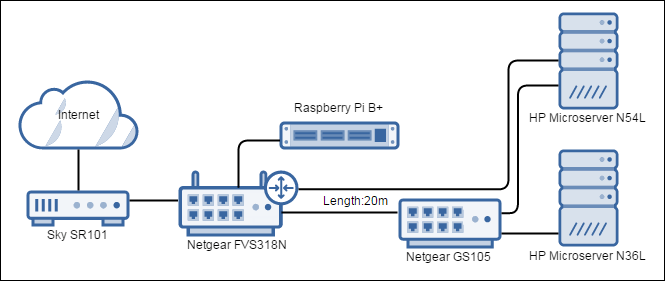
Internet
 Internet connection is supplied via ADSL, due to the distance from the exchange
the maximum connection speed is 4Mbps down and 700kbps up due to the distance
from the telephone exchange, not ideal when running a web server but currently
the cost of a fibre connection is out of my reach and a cable connection is
simply not available.
Internet connection is supplied via ADSL, due to the distance from the exchange
the maximum connection speed is 4Mbps down and 700kbps up due to the distance
from the telephone exchange, not ideal when running a web server but currently
the cost of a fibre connection is out of my reach and a cable connection is
simply not available.
I was spoilt for choice over the ADSL modem, as in the choice was spoilt by
there only being one option available as my Internet Service Provider does not
supply ADSL logon credentials, instead opting to hide the details within the
modem that is distributed with the internet subscription. Therefore I have a
Sky
SR101 ADSL router that I use as a modem only, with all traffic pushed via a DMZ
to my main router.
Router
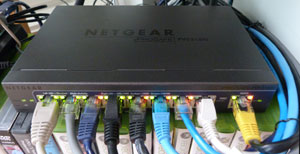 The centre of my network is a
Netgear Pro Safe FVS318N, an 8 port Gigabit router
with incorporated wireless N. I chose this as it was a managed switch with QOS
(Quality Of Service) to prioritise website traffic when I am saturating my
bandwidth by downloading files or browsing.
The centre of my network is a
Netgear Pro Safe FVS318N, an 8 port Gigabit router
with incorporated wireless N. I chose this as it was a managed switch with QOS
(Quality Of Service) to prioritise website traffic when I am saturating my
bandwidth by downloading files or browsing.
Server Connection
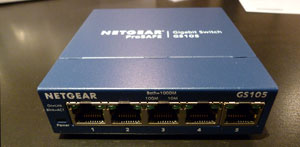 Both my HP Microserver's are connected to the router via a
Netgear GS105 switch
due to the distance between them and the router. The helps as backups between
the servers is handled by the GS105 without involving
the main router.
However the current web server has a direct connection to the main router via a
second network card, improving latency for visitors to the website, especially
when transferring data between servers.
Both my HP Microserver's are connected to the router via a
Netgear GS105 switch
due to the distance between them and the router. The helps as backups between
the servers is handled by the GS105 without involving
the main router.
However the current web server has a direct connection to the main router via a
second network card, improving latency for visitors to the website, especially
when transferring data between servers.
UPS
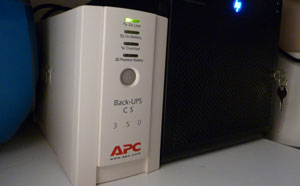 Since using hard drives in a RAID
configuration I need to deal with unexpected shutdowns, to help
preserve data both HP Microservers are connected to an APC CS350VA Online
UPS, along with the Netgear GS105. The data
port is connected to one of the servers via USB to give power status, when
running on batteries the connected server will send a shutdown command to the
other server when the low battery warning is reached, therefore it is essential
that the Netgear switch also runs off the UPS to allow the shutdown signal to
reach the other server.
Since using hard drives in a RAID
configuration I need to deal with unexpected shutdowns, to help
preserve data both HP Microservers are connected to an APC CS350VA Online
UPS, along with the Netgear GS105. The data
port is connected to one of the servers via USB to give power status, when
running on batteries the connected server will send a shutdown command to the
other server when the low battery warning is reached, therefore it is essential
that the Netgear switch also runs off the UPS to allow the shutdown signal to
reach the other server.
Media
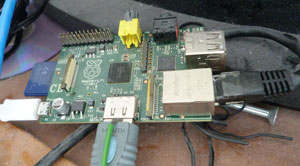 My current TV is a Sony Bravia KDL-32EX403 purchased in 2013, while it has the
ability to stream video content from the server not all file formats are
supported, so playing media is handled by a first generation Raspberry Pi
Model B
running RaspBMC, a version of XBMC compiled for the RPi. This is perfect for me
as it is capable of handling AirPlay and it is controlled by the Bravia's remote
control, giving the experience that its intergrated with the TV when the RPi is
hidden from view.
My current TV is a Sony Bravia KDL-32EX403 purchased in 2013, while it has the
ability to stream video content from the server not all file formats are
supported, so playing media is handled by a first generation Raspberry Pi
Model B
running RaspBMC, a version of XBMC compiled for the RPi. This is perfect for me
as it is capable of handling AirPlay and it is controlled by the Bravia's remote
control, giving the experience that its intergrated with the TV when the RPi is
hidden from view.